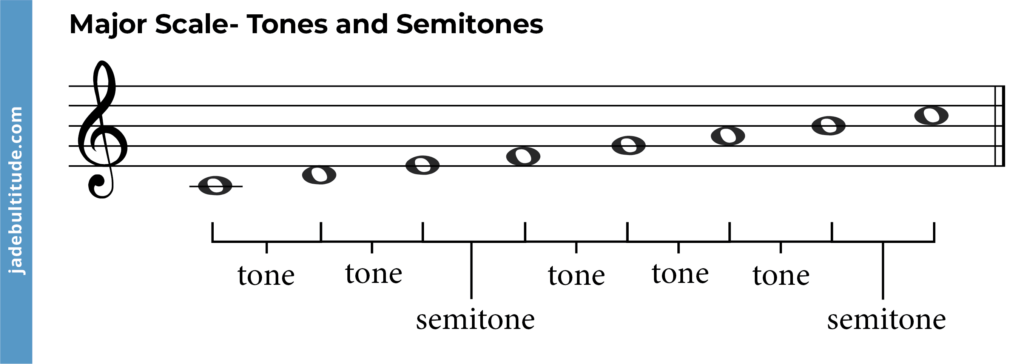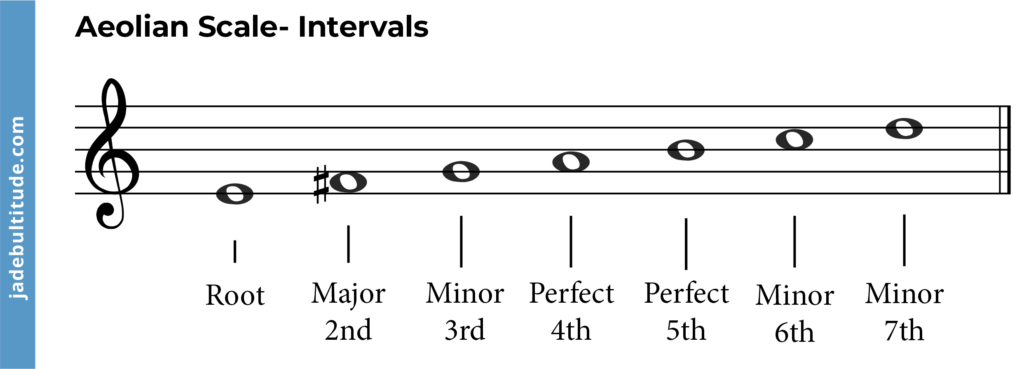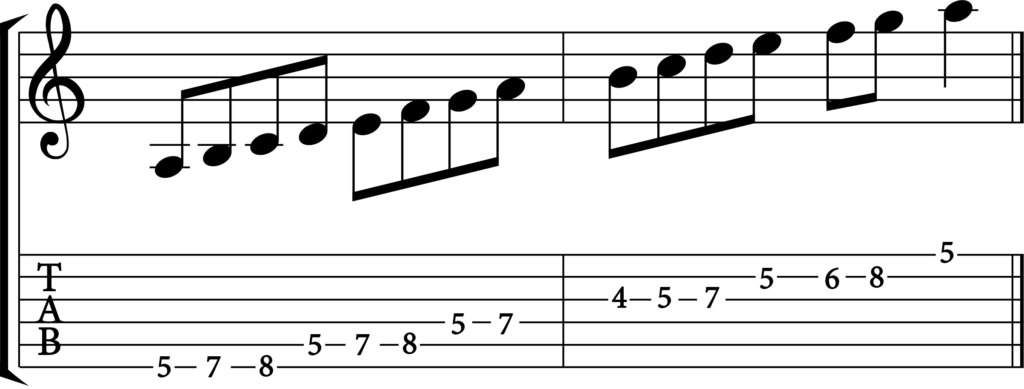There are many different scales in music and some are more common than others. You will have heard of major scales and the minor scales but the diatonic modes are something totally different. We’re going to dive into the Aeolian mode straight after a quick summary of how the modes fit together.
What are musical modes: A Summary
The musical modes are a series of seven diatonic scales based on the major scale. The modes are sometimes referred to as Greek Modes or modal scales.
In any given major key you can play all seven modes. Each of these modes will start on a different scale degree. As you can see all the different modes are very closely related.
If we look at the note sequence of the modes in the C major scale they will be as follows:
C D E F G A B C – C Ionian Mode
D E F G A B C D – D Dorian Mode
E F G A B C D E – E Phrygian mode
F G A B C D E F – F lydian mode
G A B C D E F G – G Mixolydian mode
A B C D E F G A – A Aeolian Mode
B C D E F G A B – B Locrian Mode
All the notes above use the notes from the c major scale.
What is the Aeolian Mode?
The Aeolian mode is a mode that starts on the sixth scale degree of a major scale. As we saw above, if you are in C major, the aeolian scale will begin on A. A is the sixth degree of C major. It is the sixth mode of the seven modes.
If you are in the F major scale, the aeolian mode will begin on D. D is the sixth degree of F major. The mode you create will then be the D aeolian scale.

If you are in the G major scale, the aeolian mode will be begin on E. E is the sixth degree of G major. The mode you create will then be the E aeolian scale.

From Major Scale to Aeolian Mode
As we have seen, the aeolian mode can be created from the sixth degree of a major scale. Remember scale degrees just refer to the number note of the scale.
The pattern of whole step and half steps (semitones and Tones) in the major scale is as follows:
W W H W W W H (T T S T T T S)

As the aeolian mode starts on the sixth degree of the major scale, this pattern will simply shift up.
The Aeolian Scale Formula
The pattern of whole steps and half steps (semitones and Tones) in the aeolian mode with therefore be as follows:
W H W W H W W (T S T T S T T)

Degrees of the Aeolian Scale
The aeolian mode is a minor mode. This simply means that this mode has many of the same qualities as a minor scale.
For a major scale to sound major, the third of the scale will be a major third. In the aeolian mode, this third degree is a minor third! This is what gives the scale it’s minor quality.
The degrees in the aeolian mode will be as follows:
Root
Major Second
Minor third
Perfect fourth
Perfect fifth
Minor sixth
Minor seventh

Comparing Aeolian to the Natural Minor Scale
The Aeolian Mode is actually the same as the natural minor scale. Aeolian scales share the same scale formula as a natural minor scale in western music.
If you look at the A aeolian mode written out below on the piano, you can see that only the white notes on the key board are played. A aeolian mode ( A natural minor scale) is actually the relative minor key to the major scale starting on C.

Relative keys – Aeolian and Major
Every Aeolian mode has a relative major Key (Ionian mode) and you can see this as follows:
A Aeolian – C Ionian
B Aeolian – D Ionian
C# Aeolian – E Ionian
D Aeolian – F Ionian
E Aeolian – G Ionian
F# Aeolian – A Ionian
G Aeolian – Bb Ionian
There are of course others but these are a great example.

How to Play the Aeolian Scale
You can play the Aeolian scale on any instrument. Whether you play the piano, guitar or flute all the modes will contain all the same notes on each instrument. All you must do is learn the notes of that particular mode. Once you are comfortable playing scales you can then begin to play all the modes!
For example, the a aeolian mode consists of all natural notes.
A B C D E F G A
Learn these notes and you can play it on any instrument. Below you can see the notes on the piano, notice how this scale uses only the white keys.


Music Written in the Aeolian Mode
Almost every time you hear a piece of music in a minor key, you are hearing the Aeolian mode. This is particularly true in popular music!
‘Hello‘ by Adele is an excellent example of the aeolian in use in pop music. This is written in F Aeolian scale.
‘Losing my Religion’ by REM is another great example of the aeolian scale, but this time in rock music. It is written in the a aeolian scale.
We also see it in ‘All along the watchtower’ by Bob Dylan.
We can also see examples of the aeolian scale in classical music. A great example is the ‘Moonlight Sonata’ by Beethoven. The beginning of this piece is written in the C# aeolian scale.
List of the Aeolian modes
Although the A aeolian scale is the easiest mode to create as it comes from the second note of the c major scale, meaning you only have to play the white keys on the piano, you can create an aeolian scale on any note you like! As long you keep the same interval pattern you can create the aeolian mode on any note. Each of the modes below have been created using the whole step and half step pattern we saw earlier.
A Aeolian mode – A B C D E F G A
Bb Aeolian mode – Bb, C, Db, Eb, F, G, A Bb
B Aeolian Mode – B, C#, D, E, F#, G, A, B
C Aeolian Mode – C, D, Eb, F, G, Ab, Bb, C
C# Aeolian Mode – C#, D#, E, F#, G#, A, B, C#
D Aeolian Mode – D, E, F, G, A, Bb, C, D
Eb Aeolian Mode – Eb, F, Gb, Ab, Bb, Cb, Db, Eb
E Aeolian mode – E, F#, G, A, B, C, D, E
F# Aeolian Mode – F#, G#, A, B, C#, D, E, F#
G Aeolian mode – G, A, Bb, C, D, Eb, F, G
G# Aeolian mode – G#, A#, B, C#, D#, E, F#, G#
Which chord progressions can you use the Aeolian scale with?
Aeolian scale chord progressions are a series of chords derived from the aeolian scale. To build a chord progression in the aeolian scale you must first simply choose chords that can be created with these notes. The first place to start is to create a chord (triad) on every note of the chosen aeolian mode. Below you can see a chord built on every note of the a aeolian scale, notice that none of the notes have an accidental on and this is because the a aeolian has no sharps or flats.

Each of these chords can then be labelled so you know what each chord is. If you need to learn more then check our our complete guide to chords.
Below you can see the same chords with Roman Numeral Notation.

Chord I in the a aeolian scale is the A minor chord as the interval between A and C is a minor third. We will then label this chord with a lower case i to indicate that it is a minor chord built on the root of the scale. Each chord can then be labelled in this way and we will then know which chords have a minor quality and which ones have a major quality! If the chord has a major quality the third will be a major third and we will label this chord with capital Roman numerals.
When writing a chord progression it is always advisable to use the root chord first. This will establish the key you are in.
This scale produces iio which is often avoided as it is a diminished chord.
Want to learn more?
For an overview of the modes see our complete guide for musical modes. Or see our individual guides below:
- Ionian mode
- Phrygian mode
- lydian mode
- Dorian mode
- mixolydian mode
- locrian mode
